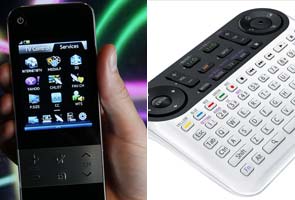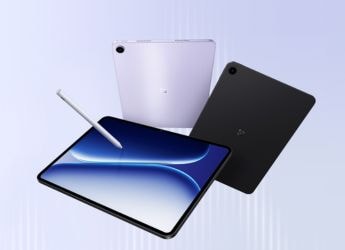Lost the remote? Use an app instead
By Joshua Brustein, New York Times | Updated: 7 June 2012 17:16 IST

Click Here to Add Gadgets360 As A Trusted Source

Advertisement
The standard TV remote control, lost so many times beneath sofa cushions, may soon be lost to history.
Good riddance, says Chris Lavoie, a radio producer living in Los Angeles. Taking advantage of advances in smartphones, Mr. Lavoie uses an app on his iPhone to control his Apple TV set-top box and search for things to watch.
But the phone is not a perfect solution. Its tendency to go into "sleep" mode can be annoying, Mr. Lavoie said, because it takes several steps to reactivate it before he can use, say, the pause button.
For basic functions, he still uses the remote that came with the box.
TV viewing habits are changing as more Internet and on-demand content -- YouTube videos, streaming movies, shopping sites, Facebook photos -- flows directly onto big screens.
Navigating all of that demands more action from the viewer, including a fair amount of typing, which current remotes cannot handle.
"Everybody realizes that the remote control is the dinosaur of the consumer electronics industry," said David Mercer, a television analyst at Strategy Analytics, a research and consulting firm.
"The cable companies and the TV manufacturers are beginning to realize that they have to start moving away from the traditional, basic remote control."
But trying to pack too many features into a remote can make it both expensive and physically imposing. Indeed, the remote Sony developed for its new Google-powered TV -- a wide device with more than 75 buttons that requires the use of both hands -- looks like the controller for a hobbyist's model airplane.
Some in the technology industry believe that a better alternative would be to simply replace the remote with smartphone apps like the one Mr. Lavoie uses. If you create a specialized smartphone app to control a TV or set-top box, you can pack the phone's touch screen with virtual buttons in any configuration you like.
There have already been successful attempts to use smartphones as remotes. Sonos, which makes Internet-connected stereos, offers a free iPhone application that replicates every feature of its own $349 touch-screen remote control.
Over half of Sonos customers now use the app, which links to the stereo over a Wi-Fi network.
Several television manufacturers, like Mitsubishi and Samsung, are following suit with smartphone remotes, and phone apps are part of both Apple and Google's TV offerings. (The phone-as-remote has an added advantage: if you lose track of it in the room, you can always call it and make it ring.)
This particular arms race may seem like a sideshow, but the lowly remote is an important piece of technology that has made its mark on television in its own way.
When it was first developed in the 1950s, manufacturers saw the remote control -- the "Lazy Bones," the earliest model, was tethered to a Zenith TV by a long cord -- primarily as a way to adjust the volume.
But it soon became clear that the remote's true calling was to enable viewers to flip through channels quickly.
Channel browsing simply would not work if the viewer had to keep getting up from the couch.
Technology giants like Apple and Google, along with a wave of Silicon Valley start-ups, have a vision for the future that would make channel-surfing seem quaint. Soon, they believe, viewers will choose from vast pools of video without distinguishing between TV broadcasts and content streamed over the Internet.
The number of homes with Internet-connected televisions is expected to reach 43 million by 2015, up from two million at the beginning of this year, according to Forrester Research, a technology research firm.
"The nature of how users access content is going to evolve, and is starting to evolve," said John Burke, the senior vice president and general manager for broadband at Motorola, which makes set-top boxes for cable providers.
"Having remote controls that give the user better ability to interact with the experience is going to be key."
Some companies are not sold on the idea of the smartphone as the remote of the future.
They are selling a range of remotes armed with full keyboards, touch screens and motion sensors.
In November, Microsoft is planning to release Kinect, a gaming system that will also allow users to move their hands and use their voices to control movies, sports and video content streamed through an Xbox console, no remote necessary.
Samsung's high-end televisions can be controlled with a touch-screen device that allows a user to pull up a virtual keyboard to type or navigate menus.
It can also display the same video that is showing on the TV, so a viewer does not miss anything while heading to the kitchen for a snack.
Samsung says it sees smartphone apps as supplements to this device; it makes its own smartphone line under the Galaxy brand.
Mitsubishi, however, sees apps as a way to replace its own hardware. It abandoned plans for a remote control with a touch screen this year because it had determined that such a device would add several hundred dollars to the price of the television.
Instead, the company is developing software for smartphones and tablets.
"If people used an iPad, that would be the best experience. We could never hope to recreate that," said Frank DeMartin, Mitsubishi's vice president for marketing.
But using a phone as a remote is not for everybody. When Chris Igoby of Washington bought his first Android smartphone in October, he immediately found an app that controlled his television.
But the high-tech novelty factor wore off quickly. On top of that, he noticed the toll it took on his phone's battery.
"It works the exact same; it works perfect," he said of the app. "But I don't understand why anyone would want to use their phone as a remote."
For his part, Mr. Lavoie supplements the iPhone app and the Apple TV remote with a universal remote for his TiVo and other devices, so he juggles all three. Still, that's better than the eight he would have otherwise, he says.
"If I can get down from eight to three, I think I'm doing pretty good," Mr. Lavoie said.
Some companies are hesitant to embrace the app idea because they balk at relying on a device or platform owned by a competitor, said Mr. Mercer at Strategy Analytics.
"It's about control of the technology, and as soon as you're talking about applications on other devices, you're allowing someone else to be dictating that environment," he said.
The issue of control could arise in living rooms as well, once everyone is carrying a personal remote control. Scott Baldwin, a spokesman for Samsung, said his company's mobile app could give a houseguest the power to change the channel against his host's wishes.
There is a low-tech solution to that, he noted: "I wouldn't invite that person over again."
Good riddance, says Chris Lavoie, a radio producer living in Los Angeles. Taking advantage of advances in smartphones, Mr. Lavoie uses an app on his iPhone to control his Apple TV set-top box and search for things to watch.
But the phone is not a perfect solution. Its tendency to go into "sleep" mode can be annoying, Mr. Lavoie said, because it takes several steps to reactivate it before he can use, say, the pause button.
For basic functions, he still uses the remote that came with the box.
TV viewing habits are changing as more Internet and on-demand content -- YouTube videos, streaming movies, shopping sites, Facebook photos -- flows directly onto big screens.
Navigating all of that demands more action from the viewer, including a fair amount of typing, which current remotes cannot handle.
"Everybody realizes that the remote control is the dinosaur of the consumer electronics industry," said David Mercer, a television analyst at Strategy Analytics, a research and consulting firm.
"The cable companies and the TV manufacturers are beginning to realize that they have to start moving away from the traditional, basic remote control."
But trying to pack too many features into a remote can make it both expensive and physically imposing. Indeed, the remote Sony developed for its new Google-powered TV -- a wide device with more than 75 buttons that requires the use of both hands -- looks like the controller for a hobbyist's model airplane.
Some in the technology industry believe that a better alternative would be to simply replace the remote with smartphone apps like the one Mr. Lavoie uses. If you create a specialized smartphone app to control a TV or set-top box, you can pack the phone's touch screen with virtual buttons in any configuration you like.
There have already been successful attempts to use smartphones as remotes. Sonos, which makes Internet-connected stereos, offers a free iPhone application that replicates every feature of its own $349 touch-screen remote control.
Over half of Sonos customers now use the app, which links to the stereo over a Wi-Fi network.
Several television manufacturers, like Mitsubishi and Samsung, are following suit with smartphone remotes, and phone apps are part of both Apple and Google's TV offerings. (The phone-as-remote has an added advantage: if you lose track of it in the room, you can always call it and make it ring.)
This particular arms race may seem like a sideshow, but the lowly remote is an important piece of technology that has made its mark on television in its own way.
When it was first developed in the 1950s, manufacturers saw the remote control -- the "Lazy Bones," the earliest model, was tethered to a Zenith TV by a long cord -- primarily as a way to adjust the volume.
But it soon became clear that the remote's true calling was to enable viewers to flip through channels quickly.
Channel browsing simply would not work if the viewer had to keep getting up from the couch.
Technology giants like Apple and Google, along with a wave of Silicon Valley start-ups, have a vision for the future that would make channel-surfing seem quaint. Soon, they believe, viewers will choose from vast pools of video without distinguishing between TV broadcasts and content streamed over the Internet.
The number of homes with Internet-connected televisions is expected to reach 43 million by 2015, up from two million at the beginning of this year, according to Forrester Research, a technology research firm.
"The nature of how users access content is going to evolve, and is starting to evolve," said John Burke, the senior vice president and general manager for broadband at Motorola, which makes set-top boxes for cable providers.
"Having remote controls that give the user better ability to interact with the experience is going to be key."
Some companies are not sold on the idea of the smartphone as the remote of the future.
They are selling a range of remotes armed with full keyboards, touch screens and motion sensors.
In November, Microsoft is planning to release Kinect, a gaming system that will also allow users to move their hands and use their voices to control movies, sports and video content streamed through an Xbox console, no remote necessary.
Samsung's high-end televisions can be controlled with a touch-screen device that allows a user to pull up a virtual keyboard to type or navigate menus.
It can also display the same video that is showing on the TV, so a viewer does not miss anything while heading to the kitchen for a snack.
Samsung says it sees smartphone apps as supplements to this device; it makes its own smartphone line under the Galaxy brand.
Mitsubishi, however, sees apps as a way to replace its own hardware. It abandoned plans for a remote control with a touch screen this year because it had determined that such a device would add several hundred dollars to the price of the television.
Instead, the company is developing software for smartphones and tablets.
"If people used an iPad, that would be the best experience. We could never hope to recreate that," said Frank DeMartin, Mitsubishi's vice president for marketing.
But using a phone as a remote is not for everybody. When Chris Igoby of Washington bought his first Android smartphone in October, he immediately found an app that controlled his television.
But the high-tech novelty factor wore off quickly. On top of that, he noticed the toll it took on his phone's battery.
"It works the exact same; it works perfect," he said of the app. "But I don't understand why anyone would want to use their phone as a remote."
For his part, Mr. Lavoie supplements the iPhone app and the Apple TV remote with a universal remote for his TiVo and other devices, so he juggles all three. Still, that's better than the eight he would have otherwise, he says.
"If I can get down from eight to three, I think I'm doing pretty good," Mr. Lavoie said.
Some companies are hesitant to embrace the app idea because they balk at relying on a device or platform owned by a competitor, said Mr. Mercer at Strategy Analytics.
"It's about control of the technology, and as soon as you're talking about applications on other devices, you're allowing someone else to be dictating that environment," he said.
The issue of control could arise in living rooms as well, once everyone is carrying a personal remote control. Scott Baldwin, a spokesman for Samsung, said his company's mobile app could give a houseguest the power to change the channel against his host's wishes.
There is a low-tech solution to that, he noted: "I wouldn't invite that person over again."
Comments
Get your daily dose of tech news, reviews, and insights, in under 80 characters on Gadgets 360 Turbo. Connect with fellow tech lovers on our Forum. Follow us on X, Facebook, WhatsApp, Threads and Google News for instant updates. Catch all the action on our YouTube channel.
Popular on Gadgets
- Samsung Galaxy Unpacked 2025
- ChatGPT
- Redmi Note 14 Pro+
- iPhone 16
- Apple Vision Pro
- Oneplus 12
- OnePlus Nord CE 3 Lite 5G
- iPhone 13
- Xiaomi 14 Pro
- Oppo Find N3
- Tecno Spark Go (2023)
- Realme V30
- Best Phones Under 25000
- Samsung Galaxy S24 Series
- Cryptocurrency
- iQoo 12
- Samsung Galaxy S24 Ultra
- Giottus
- Samsung Galaxy Z Flip 5
- Apple 'Scary Fast'
- Housefull 5
- GoPro Hero 12 Black Review
- Invincible Season 2
- JioGlass
- HD Ready TV
- Laptop Under 50000
- Smartwatch Under 10000
- Latest Mobile Phones
- Compare Phones
Latest Gadgets
- Jolla Phone
- Realme P4x 5G
- OnePlus Ace 6T
- Nubia Flip 3
- Nubia Fold
- OPPO A6x 5G
- Samsung Galaxy Z TriFold
- Poco F8 Ultra
- Asus ProArt P16
- MacBook Pro 14-inch (M5, 2025)
- OnePlus Pad Go 2
- Poco Pad M1
- Just Corseca Skywatch Pro
- Honor Watch X5
- Acerpure Nitro Z Series 100-inch QLED TV
- Samsung 43 Inch LED Ultra HD (4K) Smart TV (UA43UE81AFULXL)
- Asus ROG Ally
- Nintendo Switch Lite
- Haier 1.6 Ton 5 Star Inverter Split AC (HSU19G-MZAID5BN-INV)
- Haier 1.6 Ton 5 Star Inverter Split AC (HSU19G-MZAIM5BN-INV)
© Copyright Red Pixels Ventures Limited 2025. All rights reserved.












